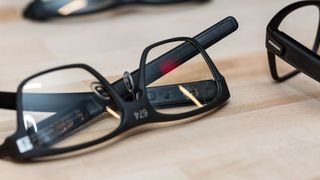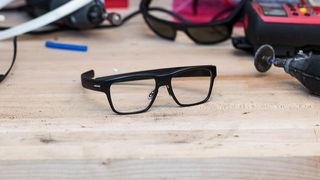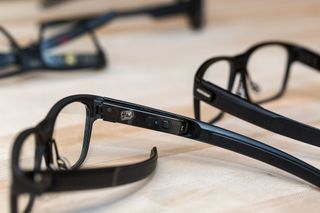Intel Vaunt: what we know so far
Intel puts a subtle spin on smart glasses

Image credit: Vjeran Pavic/The Verge
Intel has unveiled Vaunt, augmented reality (AR) smart glasses designed to be as unobtrusive as possible. If you can’t imagine wearing Magic Leap goggles or a Microsoft HoloLens visor in public, then Vaunt may be the AR solution you’re looking for.
The last quasi-mainstream smart glasses were Google Glass, which spawned story after story of “Glassholes” using the built-in camera to record people without permission, or gesturing wildly in front of nonplussed bystanders.
Unlike other smart glasses, which rely on outward-facing cameras and motion or touch controls, Vaunt gets rid of these features entirely. Intel’s New Design Group (NDG) is instead relying on a mixture of voice controls, AI, head motions and lasers to make Vaunt hands-free.
Read on the latest news and speculation on the release date, price and potential features of the Intel Vaunt augmented reality glasses.
Cut to the chase
- What is it? Augmented reality smart glasses made by Intel
- When is it out? There's no consumer release date yet, but an early access program is launching later this year for developers
- What will it cost? No pricing details yet, but Google Glass cost $1,500 (£1,000, about AU$1,589), to give you an idea
Intel Vaunt release date

The official developer kit will launch “later this year”, but Intel remains cagey on a specific date, according to The Verge.
An earlier report by Bloomberg cited sources who claimed the company plans to sell a majority stake in Vaunt to a company with solid expertise in sales channels, industry or design, rather than sell Vaunt directly to consumers.
Get the best Black Friday deals direct to your inbox, plus news, reviews, and more.
Sign up to be the first to know about unmissable Black Friday deals on top tech, plus get all your favorite TechRadar content.
Depending on how long this partner search takes and any tweaks that may happen as a result, this could delay Vaunt’s general release date. Still, this is unlikely to stop developers from getting their hands on the first version before the year is out.
Intel Vaunt price
Intel also hasn’t revealed any Intel Vaunt price information yet. Snap Spectacles only cost $130 / £105 / AU$170, while the Google Glass SDK was priced at $1,500 (£1,000 / about AU$1,956).
Where Vaunt falls depends in part on how much the proprietary Vertical-cavity surface-emitting laser (VCSEL) costs, compared to the built-in cameras found on most AR devices. Unlike its competitors, Vaunt's hardware appears to be pretty minimal, since it can fit comfortably in plastic frames.
The Verge’s Dieter Bohn, who got a first look at Vaunt, speculated that the device may rely on streaming content from apps based in the cloud, or from your smartphone via Bluetooth, to run its software. This could keep hardware requirements, as well as prices, low.
We’ll keep our eyes out for the latest info from Intel, but we’re fairly confident predicting the price will be significantly lower than that of the Magic Leap One or HoloLens. While there's no price yet for the Leap One, the HoloLens costs $3,000 (£2,719 / AU$4,369).
How it works

With most AR glasses, people around you can clearly see if you’re checking notifications or watching YouTube during a meeting. With Vaunt, the interface is nearly invisible to everyone except the wearer.
That’s because Vaunt uses a low-intensity laser to reflect your notifications directly into your right eye’s retina — except only in your peripheral vision, so it doesn’t impair your sight. The Vaunt will connect with both iOS and Android devices to pull the wearer’s notifications, similar to a smartwatch.
The designers intend wearers to be able to glance quickly into the bottom right corner of their eyesight and check for news and texts, without having to visibly pull out a phone or glance at their wrist.
The laser is a VCSEL — the same laser used by the iPhone X to scan your face for Animoji and Face ID — and one that Intel’s NDG promises is too weak to cause any retinal damage. The laser reflects off of the right lens, beaming a 400 x 150 pixel image onto the retina.
Because the image sits directly on your eye, near- or far-sighted users can see the text as clearly as someone with 20-20 vision. Of course, these users will still need prescription lenses in their Vaunts to see the outside world clearly.
The plastic frames house the laser on the right and the Bluetooth, processor, and other tech on the left, so the weight is balanced. The frames weigh about 50 grams, which is slightly heavier than regular frames; by comparison, we weighed Google Glass at 42 grams.
Intel Vaunt features

Right now, Intel is keeping the Vaunt’s potential features strictly hypothetical. But Itai Vonshak, head of products at NDG, described some potential use cases.
A baker could ask Alexa to pull up a cookie recipe. While on the phone with your mom, a calendar pop-up will remind you that her birthday is coming up. Or, a pedestrian could stare at a restaurant and, based on their GPS position and direction they’re facing, receive a Yelp pop-up with reviews — without any vocal or touch commands.
Vaunt’s AI will also be able to track subtle head movements and respond to certain commands, via a built-in accelerometer. And Intel has hinted that final models could have built-in mics to communicate with voice assistants.
Of course, we haven’t seen how these features would work in practice yet, and the Yelp example sounds particularly difficult to pull off. But NDG claims their AI will be able to send users all sorts of “ambient, contextual information” based on their position and directional gaze without the user having to actually ask for it.
“If you’re tapping and fiddling” to get information, Vonshak tells The Verge, “then we’ve lost”.
Later this year, developers will be invited to an early access program to start working with the Vaunt directly. Intel is currently working on its first-party companion app, but the indication seems to be that most apps will probably run on connected smart devices, not to your glasses directly.
- Are Apple AR glasses next on the scene?
Michael Hicks began his freelance writing career with TechRadar in 2016, covering emerging tech like VR and self-driving cars. Nowadays, he works as a staff editor for Android Central, but still writes occasional TR reviews, how-tos and explainers on phones, tablets, smart home devices, and other tech.
